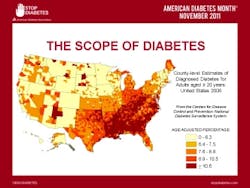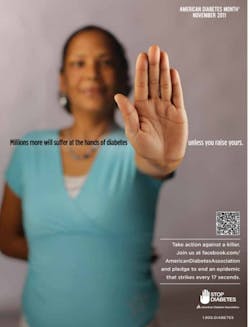Countdown to World Diabetes Day ... ABCs of diabetes ... Update on breast cancer
By Maria Perno Goldie, RDH, MS
November is: American Diabetes Month, COPD Awareness Month, Diabetic Eye Disease Month, Foot Health Issues Related to Diabetes Awareness Month, Lung Cancer Awareness Month, National Family Caregivers Month, National Healthy Skin Month, National Hospice Palliative Care Month, National Stomach Cancer Awareness Month, and Prematurity Awareness Month. Other commemorations are: Nov. 6-12: Drowsy Driving Prevention Week, Nov. 14-20: Get Smart about Antibiotics Week, Nov. 17: Great American Smokeout, Nov. 17: Prematurity Awareness Day, Nov. 19: National Survivors of Suicide Day, and Nov. 20-26: Gastroesophageal Reflux Disease Awareness Week. While we cannot address all the topics listed, we will focus on some of them.Before we leave the topics of October, I would like to address a new study (published just a few days ago) related to low levels of alcohol consumption being associated with small increased risk of breast cancer.(1) The study went from 1980 to 2008 and included 105,986 women enrolled in the Nurses' Health Study. Consumption of three (3) to six (6) alcoholic drinks per week is associated with a small increase in the risk of breast cancer, and consumption in both earlier and later adult life is also associated with an increased risk. In many studies, higher consumption of alcohol has been associated with an increased risk of breast cancer. However, the effect of low levels of drinking as is common in the United States has not been well quantified, and in fact, disputed. One epidemiological, case-control study states that, despite extensive investigation of the association between alcohol consumption and breast cancer risk, the effect of low-to-moderate alcohol intake on breast cancer incidence has been inconsistent.(2) The conclusion of the Zhang study was that low-to-moderate alcohol intake was not associated with increased risk of breast cancer in pre- or postmenopausal Chinese women. The authors of the Chen study found that when examined separately, alcohol consumption levels at ages 18 to 40 years and after age 40 years were both stronglyassociated with breast cancer risk. The association with drinking in early adult life still persisted even after controlling for alcohol intake after age 40 years. Binge drinking, but not frequency of drinking, was also associated with breast cancer risk after controlling for cumulative alcohol intake. The authors add that although the exact mechanism for the association between alcohol consumption and breast cancer is not known. One probable explanation may involve alcohol's effects on circulating estrogen levels. Their results highlight the importance of considering lifetime exposure when evaluating the effect of alcohol, and probably other dietary factors, on the carcinogenesis process. However, an individual will need to weigh the modest risks of light to moderate alcohol use on breast cancer development against the beneficial effects on cardiovascular disease to make the best personal choice regarding alcohol consumption. However, there are no data to provide assurance that giving up alcohol will reduce breast cancer risk. Future studies are required to understand differences in effect of alcohol on breast cancers by tumor hormone receptor status. As well, the role of drinking patterns, such as frequency of drinking and ‘binge’ drinking, and consumption at different times of adult life are not well understood.
November is: American Diabetes Month, COPD Awareness Month, Diabetic Eye Disease Month, Foot Health Issues Related to Diabetes Awareness Month, Lung Cancer Awareness Month, National Family Caregivers Month, National Healthy Skin Month, National Hospice Palliative Care Month, National Stomach Cancer Awareness Month, and Prematurity Awareness Month. Other commemorations are: Nov. 6-12: Drowsy Driving Prevention Week, Nov. 14-20: Get Smart about Antibiotics Week, Nov. 17: Great American Smokeout, Nov. 17: Prematurity Awareness Day, Nov. 19: National Survivors of Suicide Day, and Nov. 20-26: Gastroesophageal Reflux Disease Awareness Week. While we cannot address all the topics listed, we will focus on some of them.Before we leave the topics of October, I would like to address a new study (published just a few days ago) related to low levels of alcohol consumption being associated with small increased risk of breast cancer.(1) The study went from 1980 to 2008 and included 105,986 women enrolled in the Nurses' Health Study. Consumption of three (3) to six (6) alcoholic drinks per week is associated with a small increase in the risk of breast cancer, and consumption in both earlier and later adult life is also associated with an increased risk. In many studies, higher consumption of alcohol has been associated with an increased risk of breast cancer. However, the effect of low levels of drinking as is common in the United States has not been well quantified, and in fact, disputed. One epidemiological, case-control study states that, despite extensive investigation of the association between alcohol consumption and breast cancer risk, the effect of low-to-moderate alcohol intake on breast cancer incidence has been inconsistent.(2) The conclusion of the Zhang study was that low-to-moderate alcohol intake was not associated with increased risk of breast cancer in pre- or postmenopausal Chinese women. The authors of the Chen study found that when examined separately, alcohol consumption levels at ages 18 to 40 years and after age 40 years were both stronglyassociated with breast cancer risk. The association with drinking in early adult life still persisted even after controlling for alcohol intake after age 40 years. Binge drinking, but not frequency of drinking, was also associated with breast cancer risk after controlling for cumulative alcohol intake. The authors add that although the exact mechanism for the association between alcohol consumption and breast cancer is not known. One probable explanation may involve alcohol's effects on circulating estrogen levels. Their results highlight the importance of considering lifetime exposure when evaluating the effect of alcohol, and probably other dietary factors, on the carcinogenesis process. However, an individual will need to weigh the modest risks of light to moderate alcohol use on breast cancer development against the beneficial effects on cardiovascular disease to make the best personal choice regarding alcohol consumption. However, there are no data to provide assurance that giving up alcohol will reduce breast cancer risk. Future studies are required to understand differences in effect of alcohol on breast cancers by tumor hormone receptor status. As well, the role of drinking patterns, such as frequency of drinking and ‘binge’ drinking, and consumption at different times of adult life are not well understood.
November is American Diabetes Month. Recent numbers by the Centers for Disease Control and Prevention show us where we are, where we are headed: Every 17 seconds, someone is diagnosed with diabetes. Diabetes kills more people each year than breast cancer and AIDS combined. Recent estimates project that as many as 1 in 3 American adults will have diabetes in 2050 unless we take steps to Stop Diabetes. Resources are available in English and Spanish.(3)
According to the American Diabetes Association, nearly 26 million Americans have diabetes including seven million who don’t know it, and almost two million new cases of diabetes are diagnosed each year. Seventy-nine million Americans have prediabetes.(4) Risk factors for diabetes include: being overweight; having a parent, brother or sister has diabetes; being African American, Hispanic/Latino, Native American, Asian American or Pacific Islander; having had a baby weighing more than 9 pounds or had gestational diabetes; having high blood pressure; having low HDL (good cholesterol); or having high triglycerides. Complications include: heart disease and stroke, kidney disease, amputations, and blindness. You can help manage the risk of complications by knowing the ABCs of diabetes. A = A1c (a measure of average blood glucose); B = Blood pressure; and C = Cholesterol. Take steps to lower your risk of diabetes complications: A1c < 7, which is an estimated average glucose of 154mg/dl; Blood pressure < 130/80; Cholesterol (LDL) < 100; Cholesterol (HDL) > 40 (men) and > 50 (women); Triglycerides < 150; Get help to quit smoking; Be active; Make healthy food choices; and Talk to your doctor about medication. Increasing incidence of diabetes in the United States and risk for more severe periodontal and other diseases in persons with poorly controlled diabetes necessitate access to education to prepare oral health providers to care for this population. A survey was performed to assess the dental hygienist's knowledge of diabetes, their beliefs concerning the disease, and clinical practices to assist in identifying professional continuing education needs.(5) A five-part survey was created using the American Diabetes Association (ADA) 2007 Clinical Practice Guidelines and the American Association of Periodontology (AAP) Commissioned Review of diabetes and periodontal disease. Requests to participate in the study were disseminated electronically to American Dental Hygienists' Association (ADHA) members. A convenience sample of dental hygienists (n=392) representing 48 states participated.(5) The results of the study indicated that the majority of the respondents were female (99%), ages 41 to 60 (60.1%), and in practice more than 16 years (58.3%). Major deficits in knowledge were associated with the patient's hemoglobin A1c (HbA1c) value and implications for diabetes control (50%). The survey responses showed uncertainty about the current classifications of diabetes with 70% of respondents using classifications that were no longer recognized or accepted. Seventy-five to 90% of participants were not familiar with the impact of various types of diabetes medications on oral and dental care. The researchers concluded that dental hygienists that responded to the survey confirmed a need for further knowledge about diabetes as related to clinical patient care. The greatest need for knowledge appeared to be the American Diabetes Association Clinical Practice Guidelines for standards of care, diagnosis of diabetes mellitus, medications, and best practices for interacting with other health professionals when treating patients with diabetes.(5)November 14, 2011, is World Diabetes Day. "Diabetes Education and Prevention" is the World Diabetes Day theme for the period 2009-2013. Look for more information in this newsletter! Thank you JoAnn and Winnie to your valuable contributions to this issue of RDH eVillage FOCUS.
References
1. Chen WY. Low Levels of Alcohol Consumption Associated With Small Increased Risk of Breast Cancer. JAMA. 2011; 306 [17]: 1884-1890.
2. Zhang M and Holman CDJ. Low-to-moderate alcohol intake and breast cancer risk in Chinese women. British Journal of Cancer 105, 1089-1095 (27 September 2011).
3. www.diabetes.org/in-my-community/programs/american-diabetes-month/.
4. www.stopdiabetes.com.
5. Boyd LD, Hartman-Cunningham ML. Survey of diabetes knowledge and practices of dental hygienists. J Dent Hyg. 2008 Fall; 82(5):43.
Sincerely,
Maria Perno Goldie, RDH, MS
To read previous RDH eVillage FOCUS introductions by Editorial Director Maria Perno Goldie, go to introductions.





